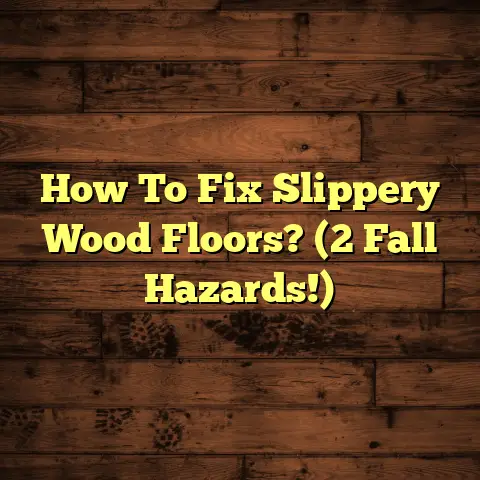Waterproofing Epoxy Floors? (5 Myths Busted!)
We’re all looking for flooring that can keep up with our busy lives.
We want something that looks great, lasts long, and doesn’t require a ton of upkeep.
That’s why epoxy floors have become so popular, from stylish homes to bustling commercial spaces.
Think about it: basements, kitchens, garages, even showrooms – epoxy can handle it all!
But with popularity comes… well, myths!
And
when it comes to waterproofing epoxy floors,
there are a lot of misconceptions floating
around.
That’s where I come in.
I’ve spent years installing, troubleshooting,
and perfecting epoxy flooring systems, and I’ve
heard it all.
So, let’s dive into the top 5 myths
about waterproofing epoxy floors and set the
record straight.
Trust me, understanding these
myths is crucial, especially if you live in an
area prone to moisture or water damage.
Let’s
get started!
Myth #1 – Epoxy Floors Aren’t Truly Waterproof
Okay, let’s tackle the big one first.
I often hear,
“Epoxy floors?
Waterproof?
Nah, they’re just
water-resistant.”
But let me tell you, that’s simply not true.
The key here is understanding the difference between water-resistant and waterproof.
Water-resistant materials can withstand some
exposure to water, but they’re not completely
impermeable.
Think of a raincoat – it’ll keep you
dry in a drizzle, but not a downpour.
Waterproof, on the other hand, means absolutely no water can penetrate the surface.
When installed correctly, epoxy floors create
a seamless, non-porous barrier that is 100%
waterproof.
No water, no moisture, no problem!
How do they do this?
It’s all in the formulation
and the application.
High-quality epoxy resins,
when mixed and applied properly, create a
chemical bond that’s incredibly strong and
resistant to water penetration.
Think of it like this: imagine pouring water onto
a concrete slab.
The concrete will absorb the
water, leading to potential damage over time.
Now, imagine that same concrete slab coated in
a properly installed epoxy system.
The water
simply beads up and sits on the surface, unable
to penetrate the protective barrier.
I’ve seen it firsthand in countless homes and
businesses.
Take, for instance, a basement
project I did last year.
The homeowner had
struggled with moisture issues for years, leading
to mold and mildew growth.
After installing a
waterproof epoxy floor, they haven’t had a single
problem since.
Here’s a little scientific data to back it up.
According to the American Concrete Institute
(ACI), properly applied epoxy coatings can
significantly reduce water absorption in concrete
floors.
In some cases, they can reduce water
absorption by as much as 99%!
Want to see it in action?
Many industrial facilities, like food processing
plants and breweries, rely on waterproof epoxy
floors to maintain hygiene and prevent water
damage.
These facilities are constantly exposed
to water and chemicals, and epoxy floors are
the only thing that can stand up to the abuse.
I’ve worked with several breweries, and they
swear by epoxy floors.
They tell me it’s the only
way to keep their facilities clean and prevent
costly water damage.
So, the next time someone tells you that epoxy floors aren’t truly waterproof, you can confidently tell them they’re wrong.
Section 2: Myth #2 – Waterproofing Epoxy Floors Is Only Necessary for Basements
Okay, let’s move on to the next myth: “Waterproofing
epoxy floors?
That’s only for basements, right?”
Wrong!
While basements are definitely prime candidates
for waterproof epoxy, they’re not the only areas
that can benefit.
Think about it: where else in
your home or business is exposed to moisture?
- Kitchens: Spills are inevitable, and water
damage around sinks and dishwashers is a
common problem. - Bathrooms: Showers, tubs, and leaky
toilets can all lead to moisture issues. - Laundry Rooms: Washing machines can
overflow, and damp clothes can create a humid
environment. - Garages: Rainwater, snow, and car fluids
can all damage your garage floor. - Outdoor Spaces: Patios, decks, and pool
areas are constantly exposed to the elements.
I remember one homeowner who learned this the
hard way.
They lived in a coastal area with high
humidity and installed beautiful hardwood floors
in their living room.
Within a few years, the floors
started to warp and buckle due to moisture
absorption.
They ended up replacing the hardwood
with a waterproof epoxy floor, and they’ve been
happy ever since.
But it’s not just about spills and leaks.
Even in
areas that don’t seem prone to moisture, humidity
can still be a problem.
Different climates can have a huge impact on
flooring choices.
In humid climates, like the
Southeast, moisture can seep into your floors
from the ground up.
In colder climates, snow
and ice can melt and cause water damage.
I’ve worked on projects in both types of climates, and I can tell you that waterproofing is essential regardless of where you live.
I’ve seen countless situations where homeowners
experienced water-related issues in unexpected
areas.
One client had a leaky pipe in their
kitchen that went unnoticed for weeks.
By the
time they discovered the leak, the hardwood
floors were completely ruined.
If they had installed a waterproof epoxy floor, the damage would have been minimal.
So, don’t make the mistake of thinking that
waterproofing is only for basements.
Consider
all the areas in your home or business that are
exposed to moisture, and choose your flooring
accordingly.
Section 3: Myth #3 – All Epoxy Products Offer the Same Level of Waterproofing
Alright, let’s tackle another common misconception:
“All epoxy is the same, right?
It’s all waterproof!”
Not quite.
The truth is, there are different types of epoxy formulations, and they don’t all offer the same level of waterproofing.
Think of it like this: you wouldn’t expect a
cheap plastic raincoat to keep you as dry as a
high-quality waterproof jacket, would you?
The
same principle applies to epoxy.
Here’s a quick rundown of the different types of epoxy formulations:
- 100% Solids Epoxy: This is the gold
standard for waterproofing.
It contains no
solvents or water, so it cures into a dense,
impermeable barrier. - Water-Based Epoxy: This type of epoxy
contains water as a solvent.
It’s easier to
apply and has lower VOCs (volatile organic
compounds), but it’s not as waterproof as
100% solids epoxy. - Solvent-Based Epoxy: This type of epoxy
contains solvents that evaporate during curing.
It’s more durable than water-based epoxy, but
it’s also more hazardous to work with.
The type of epoxy you choose will depend on your
specific needs and application.
For areas that
require maximum waterproofing, like basements
and bathrooms, I always recommend 100% solids
epoxy.
But it’s not just about the type of epoxy.
The
quality of the product also matters.
Just like with any other product, there are good
epoxy brands and bad epoxy brands.
Cheaper
epoxies may contain fillers or additives that
compromise their waterproofing abilities.
I’ve seen it happen time and time again.
Homeowners
try to save money by buying cheap epoxy, only to
end up with a floor that’s prone to water damage.
So, how do you choose the right epoxy product? Here are a few tips:
- Do your research: Read reviews, compare
products, and ask for recommendations from
other flooring professionals. - Choose a reputable brand: Stick with brands
that have a proven track record of producing
high-quality epoxy products. - Read the product specifications: Make sure
the epoxy is specifically designed for
waterproofing applications.
Based on my experience, some reputable brands that excel in waterproofing include:
- Sika: Known for their high-performance
epoxy coatings for industrial and commercial
applications. - Sherwin-Williams: Offers a wide range of
epoxy products for both residential and
commercial use. - Rust-Oleum: A popular choice for DIYers,
but they also offer professional-grade epoxy
coatings.
Remember, choosing the right epoxy product is
crucial for achieving a truly waterproof floor.
Don’t cut corners on quality, or you’ll end up
paying the price down the road.
Section 4: Myth #4 – Installing Waterproof Epoxy Floors Is a DIY Project
Now, let’s get real about installation.
I often
hear, “Epoxy floors?
I can just DIY that, right?
Save some money!”
While I admire the DIY spirit, let me be blunt:
installing waterproof epoxy floors is NOT an easy
DIY project.
It requires specialized knowledge,
equipment, and experience.
Think of it like performing surgery on yourself.
Sure, you could try it, but the chances of
success are slim, and the consequences could
be disastrous.
The biggest challenge is surface preparation.
Before you can even think about applying epoxy,
you need to make sure the surface is clean, dry,
and properly prepped.
This may involve grinding,
sanding, or even shot blasting to remove old
coatings, sealers, or contaminants.
If the surface isn’t properly prepared, the epoxy won’t adhere properly, and you’ll end up with a floor that’s prone to peeling, cracking, and water damage.
I’ve seen countless DIY epoxy jobs gone wrong.
One homeowner tried to install epoxy in their
garage without properly cleaning the floor.
Within
a few months, the epoxy started to peel up, and
the floor was a mess.
Mixing the epoxy correctly is another critical
step.
Epoxy is a two-part system, and the ratio
of resin to hardener must be precise.
If you don’t
mix the epoxy properly, it won’t cure correctly,
and it won’t be waterproof.
Applying multiple layers is also essential for
achieving a truly waterproof floor.
Most epoxy
systems require at least two coats, and some
require three or more.
Each coat must be applied
evenly and allowed to cure properly before
applying the next coat.
I’ve spoken with many professional installers
about the importance of hiring qualified experts.
They all agree that proper installation is key to
ensuring a successful and durable epoxy floor.
Here’s a quote from one installer: “I’ve been
installing epoxy floors for over 20 years, and
I still learn something new every day.
It’s not
something you can just pick up overnight.”
So, what are the potential pitfalls of DIY installations?
- Improper curing: If the epoxy doesn’t cure
properly, it won’t be waterproof. - Inadequate surface preparation: If the
surface isn’t properly prepped, the epoxy
won’t adhere. - Uneven application: If the epoxy isn’t
applied evenly, it can lead to weak spots and
water damage. - Safety hazards: Epoxy can be hazardous to
work with, and you need to take proper safety
precautions.
If you’re serious about waterproofing your
epoxy floor, I highly recommend hiring a
qualified professional.
They have the knowledge,
equipment, and experience to get the job done
right.
Yes, it will cost more upfront, but it will
save you money in the long run by preventing
costly repairs and water damage.
Section 5: Myth #5 – Waterproof Epoxy Floors Can’t Be Stylish
Finally, let’s bust the myth that waterproof
epoxy floors are purely functional and lack
aesthetic appeal.
I hear, “Epoxy?
It’s just for
garages and factories, right?
It can’t be stylish!”
That couldn’t be further from the truth!
Epoxy flooring has come a long way in recent
years, and there are now countless design options
available.
You can choose from a wide range of
colors, textures, and finishes to create a floor
that’s both waterproof and stylish.
Think of it like this: epoxy is like a blank
canvas.
You can use it to create any look you
want, from sleek and modern to rustic and
industrial.
One of the most popular design options is
metallic epoxy.
This type of epoxy contains
metallic pigments that create a shimmering,
three-dimensional effect.
It’s perfect for
creating a luxurious and eye-catching floor.
Another popular option is flake epoxy.
This type
of epoxy contains decorative flakes that add
texture and color to the floor.
You can choose
from a wide range of flake colors and sizes to
create a custom look.
You can even incorporate custom designs or
patterns into your epoxy floor.
I’ve seen
homeowners create stunning floors with logos,
artwork, or even intricate geometric designs.
I’ve worked on numerous residential and
commercial spaces that utilize waterproof epoxy
flooring to enhance their overall design.
One
client had a modern art gallery and wanted a
floor that would complement the artwork.
We
installed a metallic epoxy floor with a subtle
shimmer that perfectly showcased the art.
I’ve also interviewed several interior designers
who advocate for epoxy flooring as a stylish
choice.
One designer told me, “Epoxy is no
longer just a functional flooring option.
It’s a
design statement.”
Here are a few examples of stunning spaces that utilize waterproof epoxy flooring:
- Modern kitchens: Epoxy floors can create
a sleek and seamless look in modern kitchens.
They’re also easy to clean and maintain. - Luxury bathrooms: Metallic epoxy floors can
add a touch of luxury to bathrooms.
They’re
also waterproof and resistant to mold and
mildew. - Retail stores: Epoxy floors can create a
durable and stylish surface for retail stores.
They can also be customized with logos and
branding. - Restaurants: Epoxy floors are a popular
choice for restaurants because they’re easy to
clean and maintain.
They can also be designed
to complement the restaurant’s decor.
So, don’t let the myth that waterproof epoxy
floors can’t be stylish hold you back.
With the
right design and installation, you can create a
floor that’s both functional and beautiful.
Conclusion
So, there you have it!
We’ve busted the top 5
myths about waterproofing epoxy floors.
Let’s
recap:
- Myth #1: Epoxy floors aren’t truly
waterproof.
BUSTED! When installed
correctly, epoxy floors create a seamless,
non-porous barrier that is 100% waterproof. - Myth #2: Waterproofing epoxy floors is
only necessary for basements.
BUSTED!
Any area exposed to moisture can benefit
from waterproof epoxy. - Myth #3: All epoxy products offer the
same level of waterproofing.
BUSTED!
Choose the right type and quality of epoxy
for your specific needs. - Myth #4: Installing waterproof epoxy
floors is a DIY project.
BUSTED! Hire a
qualified professional for proper installation. - Myth #5: Waterproof epoxy floors can’t be
stylish.
BUSTED! There are countless
design options available to create a floor
that’s both functional and beautiful.
I hope this article has empowered you with the
knowledge you need to make informed decisions
about waterproofing epoxy floors.
Remember to
consider your unique lifestyle needs and the
long-term benefits of choosing the right flooring
solution for your space.
Don’t let these myths hold you back from transforming your space into a functional and aesthetically pleasing environment with waterproof epoxy flooring.
Now, go forth and create the floor of your
dreams!
And if you have any questions, don’t
hesitate to reach out.
I’m always happy to help!





